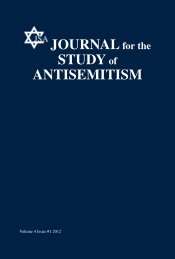JOURNALfor the STUDYof ANTISEMITISM
JOURNALfor the STUDYof ANTISEMITISM
JOURNALfor the STUDYof ANTISEMITISM
Create successful ePaper yourself
Turn your PDF publications into a flip-book with our unique Google optimized e-Paper software.
2011] THE CONVERSOS 131<br />
<strong>the</strong>y had Jewish ancestry, had practices considered consistent with a Jewish<br />
heritage, or reported traditions about only marrying with certain families<br />
(historian Cecil Roth, for example, was aware of only faint echoes and individual<br />
persons who claimed Marrano ancestry).<br />
For <strong>the</strong> most part, persons of converso heritage were unaware of any<br />
Jewish practices or beliefs in <strong>the</strong>ir families, and if <strong>the</strong>y had unusual practices<br />
would not have described <strong>the</strong>m as Jewish, at least in public, nor did<br />
<strong>the</strong>y establish formal communities. Venta Prieta in Mexico was a rare<br />
exception. Raphael Patai published two important studies on <strong>the</strong> Indian<br />
Jews of Venta Prieta; he discounted converso heritage in his first published<br />
study, although he modified his views in a later study. O<strong>the</strong>rwise, <strong>the</strong>re was<br />
little general awareness of <strong>the</strong> survival of any Jewish elements of belief,<br />
practice, or identity among populations that might have included descendants<br />
of conversos.<br />
In <strong>the</strong> final quarter of <strong>the</strong> 20th century, persons of Hispanic heritage in<br />
general came into more contact with Jews and more into <strong>the</strong> American<br />
mainstream. There was a growing acceptance of multiculturalism in<br />
America, television programs such as Roots emphasized <strong>the</strong> search for heritage,<br />
and, perhaps most relevant for readers of this journal, <strong>the</strong> level of<br />
antisemitism appears to have declined among Hispanos and everyone<br />
else—at least in <strong>the</strong> United States. It is hardly surprising that <strong>the</strong>re was a<br />
major change in attitudes and openness: The persistence of Jewish heritage<br />
among persons of Hispanic heritage began to be discussed more frequently<br />
with outsiders, at first only behind closed doors, and appeared in popular<br />
accounts and in research. Hispanos who came into contact with Jewish families<br />
wondered whe<strong>the</strong>r some of <strong>the</strong>ir own family practices had a Jewish<br />
source. 3<br />
One component of this phenomenon involves <strong>the</strong> discovery or determination<br />
of Jewish ancestry. It seems to me that <strong>the</strong> sheer number of conversos<br />
and <strong>the</strong>ir descendants’ eventual intermarriage with all ranks of Spanish<br />
society make it statistically improbable that any person of predominantly<br />
Spanish heritage alive today is totally devoid of Jewish ancestors. This<br />
fact—or at least <strong>the</strong> high likelihood of common ancestry between modern<br />
Jews and Spaniards or Hispanos—is not only indicated by research suggesting<br />
a high preponderance of common Y-chromosome haplotypes, but<br />
also somewhat obscured by this research. Suppose <strong>the</strong>re are some 20 generations<br />
since <strong>the</strong> late 1300s—and thus 2 20 , or over one million, distinct possi-<br />
3. I discussed <strong>the</strong> literature up to <strong>the</strong> mid-1990s and noted its growth elsewhere.<br />
See Seth Ward, “Converso Descendants in <strong>the</strong> American Southwest: A<br />
Report on Research, Resources, and <strong>the</strong> Changing Search for Identity,” Proceedings<br />
of <strong>the</strong> 6th EAJS Toledo, 1998.














